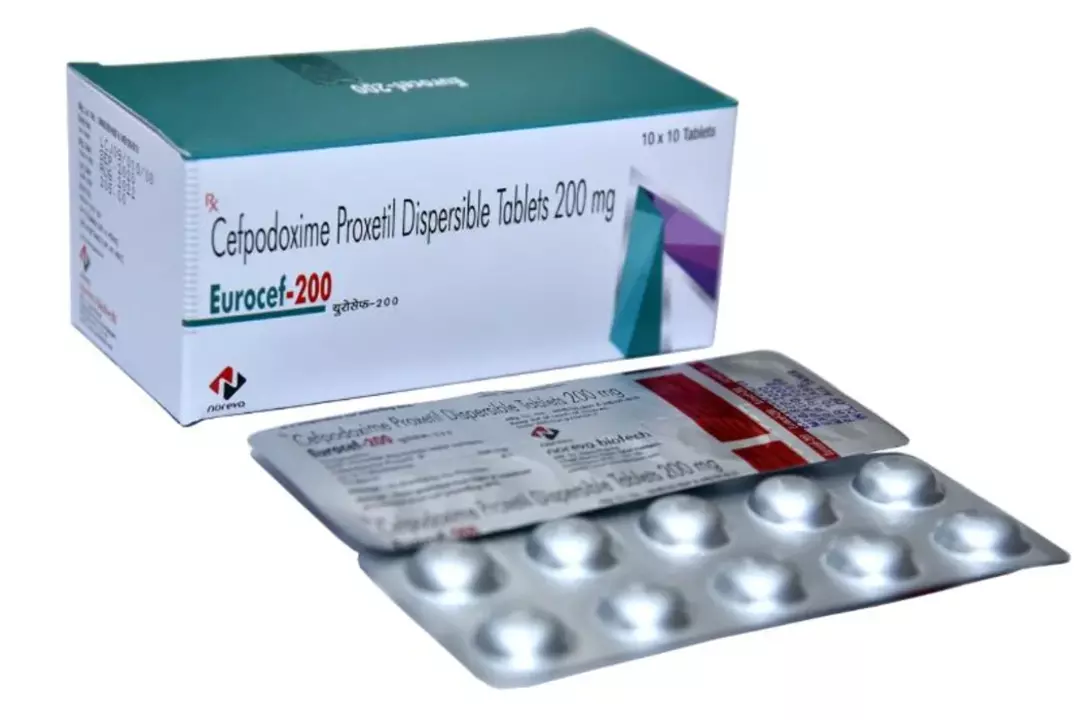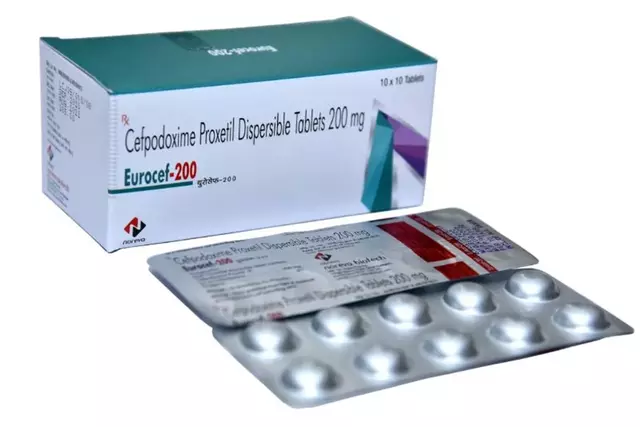A guide to proper cefpodoxime dosage and administration
Understanding Cefpodoxime and Its Uses
Before diving into the proper dosage and administration of cefpodoxime, it's essential to understand what this medication is and why it's prescribed. Cefpodoxime is an antibiotic that belongs to the cephalosporin class of drugs. It's used to treat various bacterial infections, including respiratory tract infections, skin infections, and urinary tract infections, among others. By inhibiting the growth of bacteria, cefpodoxime helps our body's immune system effectively combat infections.
Cefpodoxime works by targeting the bacteria's cell wall, ultimately weakening it and causing the bacteria to die. It's crucial to remember that this antibiotic only works against bacterial infections and won't be effective against viral infections like the common cold or flu. Using antibiotics when they're not needed can lead to antibiotic resistance, a significant public health concern.
General Dosage Guidelines for Cefpodoxime
As with any medication, it's essential to follow the appropriate dosage guidelines for cefpodoxime to ensure its effectiveness and minimize the risk of side effects. The dose of cefpodoxime will vary depending on the type and severity of the infection being treated, as well as the patient's age, weight, and kidney function.
For adults, the typical dosage range for cefpodoxime is 100-400 mg taken orally every 12 hours. For children, the dose is usually calculated based on their weight, with a typical range of 5-10 mg/kg per day, divided into two doses. It's important to note that these are general guidelines, and your healthcare provider will determine the appropriate dose for you or your child based on the specific circumstances.
To ensure the effectiveness of cefpodoxime, it's crucial to take the medication at evenly spaced intervals and for the entire duration prescribed by your healthcare provider. Stopping the medication too soon could lead to a relapse of the infection or the development of antibiotic resistance.
Proper Administration of Cefpodoxime
Now that we've covered the basics of cefpodoxime dosage, let's discuss the proper administration of this medication. Cefpodoxime is usually available in tablet or oral suspension (liquid) form. It's essential to carefully follow the instructions provided by your healthcare provider and the information on the prescription label.
For the tablet form, cefpodoxime should be taken with food to enhance its absorption and minimize the risk of stomach upset. Swallow the tablet whole, without crushing or chewing it. If you have difficulty swallowing tablets, ask your pharmacist if the tablet can be split or if the oral suspension form would be more suitable.
For the oral suspension, make sure to shake the bottle well before each use. Use the provided measuring device (such as a dosing cup or oral syringe) to accurately measure the correct dose. Do not use a household spoon, as it may not provide an accurate measurement.
Managing Side Effects and Interactions
As with any medication, there's a potential for side effects and interactions when taking cefpodoxime. Some common side effects include diarrhea, nausea, vomiting, and headache. While most side effects are mild and temporary, it's essential to contact your healthcare provider if they persist or worsen.
In rare cases, severe side effects may occur, such as severe abdominal pain, persistent vomiting, yellowing of the eyes or skin (jaundice), dark urine, or a severe allergic reaction. Seek immediate medical attention if you experience any of these symptoms.
It's essential to inform your healthcare provider of all medications, supplements, and herbal products you're taking, as some can interact with cefpodoxime. For example, antacids containing aluminum or magnesium can reduce the absorption of cefpodoxime, and blood thinners like warfarin may interact with cefpodoxime, increasing the risk of bleeding.
Ensuring Safe and Effective Use of Cefpodoxime
In conclusion, proper dosage and administration of cefpodoxime are crucial for the safe and effective treatment of bacterial infections. By following the guidelines provided by your healthcare provider and the information on the prescription label, you can help ensure the best possible outcome while minimizing the risk of side effects and antibiotic resistance.
Remember, it's essential to complete the entire course of antibiotics, even if you start feeling better before the medication is finished. This helps to ensure that the infection is fully treated and reduces the risk of developing antibiotic-resistant bacteria. If you have any concerns or questions about cefpodoxime, don't hesitate to reach out to your healthcare provider or pharmacist for guidance.










Cefpodoxime? Bro, I took this for my sinus infection and woke up feeling like a zombie who swallowed a dictionary. Also, why does it come in a liquid that tastes like regret and chalk?
i took this last year for a bad UTI and honestly it worked great but i forgot to take it with food once and my stomach was not happy lol. pls eat something before you swallow these pills. your gut will thank you.
It's fascinating how we've come to rely on synthetic molecules to correct the natural imbalance of our microbial ecosystems, isn't it? We've turned our bodies into battlegrounds where pharmaceuticals wage war on invisible enemies, yet we rarely ask why the war began in the first place. The true antibiotic resistance isn't in the bacteria-it's in our willingness to reach for a pill before we even consider rest, hydration, or the quiet wisdom of our own immune systems.
So you're telling me I need to take this with FOOD? Like, actual meals? Not just a protein shake I poured into a mug at 2 a.m.? I'm sorry, I thought this was medicine, not a cooking class.
in india we call this "cef 200" and everyone knows you take it after roti and dal. dont take it on empty stomach unless you wanna meet your toilet like 3x in 10 mins. also dont mix with alcohol-your liver will side-eye you
I took this for a UTI last month. It worked. I didn't die. I'm alive to tell you: take it with food.
Let’s be honest: the FDA doesn’t care about your gut. They care about patents. Cefpodoxime? It’s just a slightly newer version of a 1980s drug repackaged with a fancy label and a 300% markup. And you’re supposed to swallow it with food? That’s not a medical guideline-that’s a corporate afterthought disguised as science.
Cefpodoxime? More like cefpox-why-did-i-take-this? I swear this stuff is just sugar pills with a side of diarrhea. Also, did you know the FDA approved this after a 12-minute Zoom call with a guy named Steve? I read it on a forum.
This entire post is a government psyop. Cefpodoxime doesn’t kill bacteria-it reprograms them to work for Big Pharma. The 'side effects' are just the bacteria screaming as they're turned into corporate spies. Also, the 'oral suspension' is just a placebo with food coloring and a hidden tracking chip.
you got this 💪 take it with food, finish the whole course, and your body will thank you later. you're stronger than this infection. stay hydrated and trust the process 🙌
I must commend the precision of the clinical guidelines presented herein. The delineation between bacterial and viral etiologies is not only scientifically accurate but ethically imperative. One cannot overstate the societal ramifications of antimicrobial stewardship. That said, the suggestion to administer with food is, regrettably, under-emphasized. I have witnessed, in my professional capacity as a clinical pharmacist, the catastrophic consequences of fasting administration: gastric distress, subtherapeutic plasma concentrations, and, in one tragic case, a cat who developed a mild case of existential dread after licking a spilled tablet. Please, for the love of microbiota, eat a cracker.
why is this even a thing? just take amoxicillin. cheaper, same effect. this cefpodoxime is just pharma trying to sell you a new toy.
amoxicillin works fine until your doc says 'oh this one's resistant' and then you're stuck with this $120 bottle of chalk dust. also, yeah, eat the damn toast.